Some years ago I read Tracy Chevalier’s historical novel Burning Bright, about a family from Dorset who earned their living by making buttons. Tracy Chevalier’s books are always a good read, but I was particularly intrigued by the buttons, as they were made by sewing, using just small metal rings and sewing thread as raw ingredients. I wondered about the technique and wanted to know what they’d look like, so it went on my mental list of things to look up further, one day, when I have a spare moment.
Needless to say I never got round to doing that, but this October, the Online Guild of Weavers, Spinners and Dyers ran a workshop on Dorset Buttons, and I immediately knew it was my chance to find out more. Not that I needed another project right at this moment, but sometimes a little random diversion is just good for you. And since most of my crafty projects normally take weeks or months (or years, as the case may be), it was almost a novelty to make something quick and relatively easy for change.
So here’s what I learned:
Making buttons was a significant cottage industry in the county of Dorset (in the South West of England) for two hundred years, from the 17th to the 19th century. Hundreds of families were involved, although they did not work as individual businesses, but made buttons for a company that supplied them with raw materials. They were not paid in cash, but in goods (to stop them being able to set up their own independent businesses), but it was nevertheless popular work as it was less strenuous than farm labouring and it could be done at home. There were a few different designs that were made, and the best buttons were exported to other countries.
Another interesting thing that came up in the workshop was that there were other regions in the UK that had their own button making industries too, each with their own distinctive styles: there were Macclesfield buttons, Blandford buttons, Yorkshire buttons, all handmade by sewing.
As with so many other traditional crafts, it was the industrial revolution that brought this cottage industry into a gradual decline. In the Great Exhibition of 1851 a button making machine was introduced and after that hand-made buttons just could not compete.
If want to know more, you can find out about the history of Dorset buttons here.
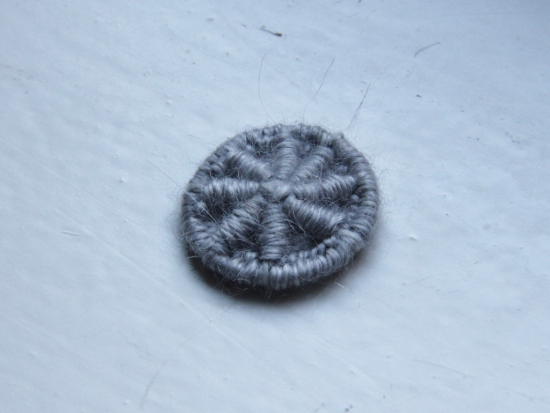
The cartwheel was one of the most popular designs. Here is my first attempt, made with a 20mm brass ring and sock yarn.
To make these buttons, you just need a needle, thread and some sort of a ring – any ring will do, but it needs to be a closed one, so no gaps. I bought a packet of 20mm soldered brass jump rings from eBay to practise with. Perhaps the most iconic design is the cartwheel and it is surprisingly easy to make, a tutorial can be found here. I also bought a little pattern booklet written by Marion Howitt.
I made my first button with some sock yarn from my stash. I found the only hard thing about making these buttons is to make them symmetrical, to make the spokes of the cartwheel stay in right in the centre, but it did not take many goes to get the hang of it. And once you have mastered the basic technique, it is very easy to come up with your own variations.
Although many people in the workshop were producing very pretty buttons using colourful and variegated yarns, and adding beads as embellishments, I decided to keep things as simple as possible. The designs of these buttons are beautiful anyway, they don’t need anything extra, I felt. So I decided to use some silk embroidery thread in very muted colours that I have been dyeing this summer using natural dyes. They allowed the designs shine without the distraction of bright colours and colour changes.
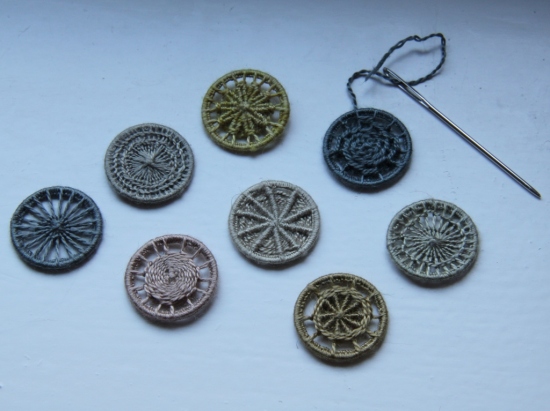
I made my buttons on 20mm brass rings and used silk embroidery thread that I have been dyeing with natural dyes this summer. Some of these are “proper” designs, others are just my own variations on the cartwheel theme.
After basic button making, the next challenge in the workshop was to make some Dorset button jewellery. I’m not a big jewellery person in general, and rarely wear any unless I’m going out for a special occasion, so I thought I’d make a simple necklace that could be worn with a black top. With pretty delicate buttons like these there’s always a risk of cuteness overload, which I definitely wanted to try to avoid, so I didn’t want anything too sweet or fussy or colourful.
I thought the Victorian Gothic Revival style might be a suitable source of inspiration, romantic but in a dark rather than a sweet way (not sure where exactly this came from, I’m not normally into a Gothic style, perhaps it’s just the dark gloomy season we’re having at the moment). I made some daisy-style buttons in slate grey, almost but not quite black silk (dyed with black hollyhock flowers) and then joined them together to make a pendant. I didn’t have any suitable ribbons for a chain, so I simply crochet’ed one with the same embroidery thread.
My silk buttons are way too delicate to use in everyday clothing, they are definitely “art buttons” rather than to be actually used. But one day, if I ever have the spare time to start making my own clothes, I am thinking these buttons, in a smaller size and made with linen tread, might look nice on some simple rustic linen clothing. Another idea for my very long “To Do One Day” list…
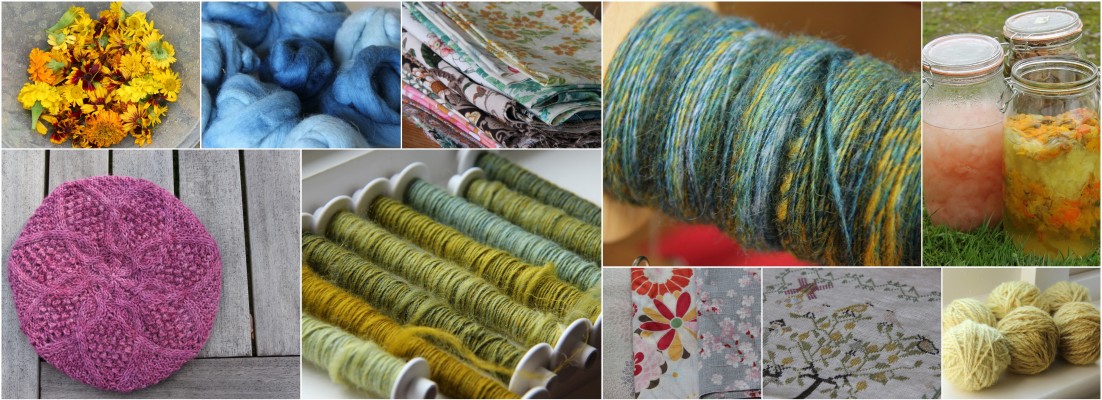
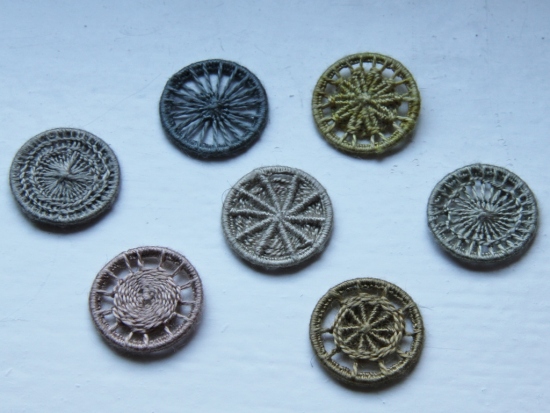
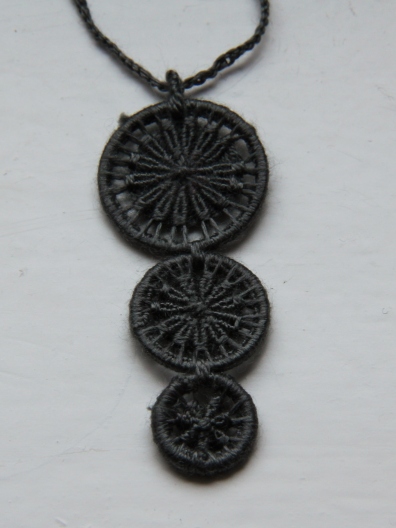
November 5, 2013 at 13:17
Hi, Dear Heidi, this is so interesting and also so nice. I haven’t seen this before. Maybe I could try. Thank you for sharing, I am same as you, I love colours, in art, photography,…etc. You can visit if you wish my blogs,
http://acupofteawithnia.wordpress.com (this is for my works, and about art)
http://www.photographyofnia.com ( only my photography)
Have a nice day,
with my love, nia
November 5, 2013 at 17:57
Thank you for visiting, Nia! I’m glad you liked the post (and so many others!)
Heidi
November 6, 2013 at 01:09
I’m glad you were able to check something off your to-do list – but now it’s on mine! These are awesome!
November 6, 2013 at 08:44
well I am pleased to pass it on 😉
February 10, 2014 at 02:48
Thanks for the post, I bought some brass rings from etsy a few months back and have been meaning to give button making a try. I might just have to have a go tonight 🙂 Lovely designs by the way.
February 10, 2014 at 10:09
Thank you, Krissie! It’s surprisingly easy, so definitely have a go – in an hour or two you’ll have mastered a new skill, so it’s very satisfying!:-)
April 8, 2014 at 14:21
I discovered Dorset buttons too a few months ago as I wanted something special to go on a vest I knitted. It is surprisingly easy. Try using silk ribbon (as in ribbon embroidery). Makes a beautiful button, as does silk thread. Look into deaths head buttons also made in northern England on a wooden base with silk thread. All very lovely!
April 9, 2014 at 09:25
Thank you for the tips RuthAnne!
June 23, 2014 at 21:16
I too was intrigued by the buttons in Burning Bright: thanks for showing your work and explaining some tips. They will continue to hover just off the bottom of my to do list, but now I know where to look when I finally decide to give them a go.